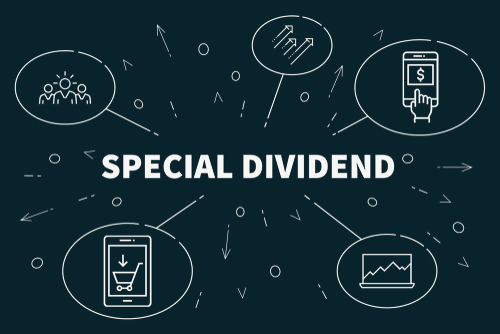Why Would a Company Issue a Special Dividend?
If you follow the stock market long enough, you’ll notice that some companies issue a special dividend. It might seem strange for a firm to set aside money for a one-time payout to shareholders, but there are a number of situations where it’s advantageous to do so. Let’s look at what a special dividend is and why some businesses prefer to pay them.
What Makes a Special Dividend Special?
When a company issues a one-time dividend, it usually does so with cash or additional shares. If the amount is less than 25% of the stock’s value, the company is obligated to set a record date and an ex-dividend date. The ex-dividend date ensures that only those who hold the stock prior to the date are paid. Also, special dividend payments tend to be much larger than normal dividends.
Tax considerations are different when it comes to special dividends. Many investors treat regular dividends as long-term capital gains, but a special one often isn’t. Some IRA and 401(k) holders get special tax deferments, although they don’t benefit from the cash issuance. In general, the government treats special dividends as returns on capital. Shareholders usually receive a 1099-DIV. But on the upside, the issuance of stock does not lead to a change in a shareholder’s basis cost.
You can learn more about dividend taxes by checking out this link on IRS.gov.
Market Reactions
As is the case with most dividends, the market tends to mark the price of the stock down by the amount of the dividend. If a firm, for example, issues a $2 per share payout, its share price will see a similar drop. In fact, these drops often occur well before payouts if the market sees them coming.
No Long-Term Obligations
Some firms, such as Diamond Offshore Drilling (NYSE: DO), have gone to issuing one-time dividends on a quarterly basis. Investors consider them special dividends because the company takes the time to schedule them as such. The advantage for a drilling company is simple. The industry is cyclical and it’s hard to pay consistent dividend amounts. Also, reversing a declared dividend can be a lengthy process. If a firm is worried about cash flow problems, it can simply stop scheduling the special dividend. This helps a company respond to macro trends outside of its control.
Reorganization
Some companies free up cash when reorganizing through mergers, acquisitions and spinoffs. The company can then use the surplus of cash as a special dividend. For example, SAIC spun off a part of its business in 2013, and prior to the change in organization, SAIC issued a special disbursement.
Rewarding Shareholders
Apple (Nasdaq: AAPL) has a long history of being stingy with dividends. Its cash on hand represents more than a good chunk of the company’s overall market cap. In return for shareholders being patient with the firm’s low payouts on regular dividends, Apple occasionally issues special ones.
Microsoft (Nasdaq: MSFT) took a similar tactic in 2004 when it issued $32 billion in cash to its shareholders. In the case of Microsoft, it appears the intent was to reward board members. They wanted to take some cash out before heading in different directions.
Annual Payouts
Some firms prefer to pay decent quarterly dividends on a regular basis and then do annual special disbursements. Ford (Nasdaq: F), for example, has often elected to issue an annual dividend as a special payment, calculating the amount to be roughly 50% of adjusted EPS.
Conclusion
Special dividends can help companies navigate unique situations and reward shareholders. They also allow firms to maintain tighter control over when to make cash disbursements.
To learn more about dividend investing, check out our recent dividend research articles.
Good investing,
Rob
